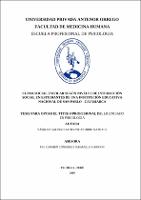Clima social escolar según niveles de interacción social en estudiantes de una institución educativa nacional de San Pablo - Cajamarca

Ver/
Descargar
(application/pdf: 162.6Kb)
(application/pdf: 162.6Kb)
Fecha
2019Autor(es)
Vásquez Gálvez, Katherine Asthrid Nathaly
Metadatos
Mostrar el registro completo del ítemResumen
El presente trabajo tiene como objetivo evaluar el Clima Social Escolar según los niveles de Interacción Social en estudiantes del nivel secundario. Para esta evaluación se utilizaron dos instrumentos, el primero, la Escala de Clima Social Escolar (CES) que fue elaborado por R.H Moos y E.J. Tricket; así mismo se utilizó la técnica del Sociograma, que tiene como objetivo dividir la población en tres categorías, estudiantes aceptados, rechazados y aislados. El tipo de investigación que se utilizó fue sustantiva y el diseño descriptivo comparativo. El objetivo de este estudio fue conocer la diferencia entre el Clima Social Escolar y los niveles de Interacción Social (aceptados, rechazados y aislados) en estudiantes de una Institución Educativa Nacional de Cajamarca, es así que la población utilizada para este estudio fueron 600 estudiantes y la muestra de 234, los cuales fueron escogidos mediante muestreo probabilístico. Se llegó a la conclusión que existe diferencia significativa en todas las dimensiones del Clima Social Escolar (relaciones, autorrealización, estabilidad, cambio) entre estudiantes aceptados, rechazados y aislados. The objective of this work is to evaluate the School Social Climate according to the levels of Social Interaction in secondary school students. For this evaluation, two instruments were used, the first one, the School Social Climate Scale (CES), which was prepared by R.H Moos and E.J. Tricket; Likewise, the Sociograma technique was used, which aims to divide the population into three categories, accepted, rejected and isolated students. The type of research that was used was substantive and the descriptive comparative design. The objective of this study was to know the difference between the School Social Climate and the levels of Social Interaction (accepted, rejected and isolated) in students of a National Educational Institution of Cajamarca, so the population used for this study was 600 students and the sample of 234, which were chosen by probabilistic sampling. It was concluded that there is a significant difference in all the dimensions of the School Social Climate (relationships, self-realization, stability, change) among accepted, rejected and isolated students.
Palabras clave
Colecciones
- Psicología [531]

